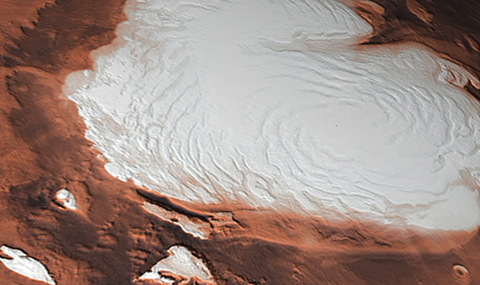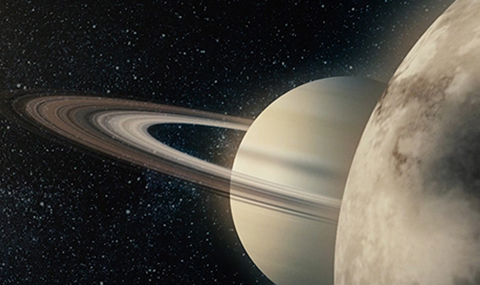Facility
The regolith of Mars represents a significant reservoir of water in the form of ice, adsorbed water, and surface frosts and mantles. The subsurface can couple strongly with atmospheric water vapor and the exchange between the two is an important process on timescales from diurnal to hundreds of thousands of years. Exchange rates for the gain and loss of ice depend on the thermal characteristics of the regolith and its geometric structure. The latter of these is characterized by the diffusion coefficient; a parameter which is difficult to fully characterize in idealized models, and is most often determined empirically for terrestrial soils.
The Caltech Ice and Mars Simulation Laboratory (or “The Ice Lab”) consists of several rooms in the North Mudd building of the California Institute of Technology campus in Pasadena. The Ice Lab consists of two walk-in freezers (-15 and -40 ℃) which are used to grow and preserve custom ices with particular characteristics, serve as temperature control for Mars-environment chambers used in diffusion experiments, and store Arctic and Antarctic ice cores for future analysis. An additional custom freezer box designed to accept a vacuum chamber is capable of maintaining temperatures down to -80 ℃ for long duration experiments. Two anterooms are used for sample preparation and instrument construction. One room also houses the recirculating methanol chiller used in various experiments to cool samples down to -85 ℃.
 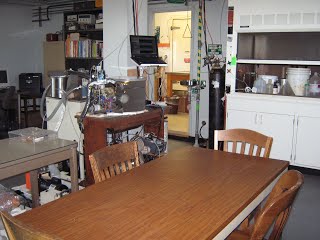 |
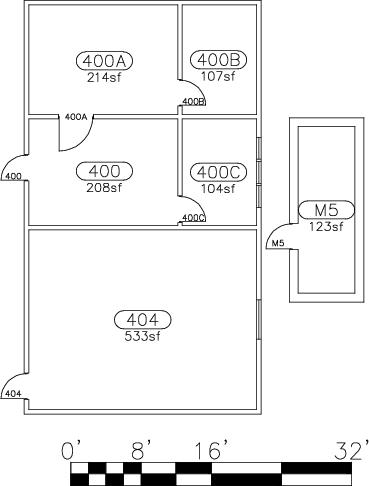 |
| (Above) The lab was renovated and adopted for use for planetary ice experiments. It covers 1,289 ft2 of area, with two walk-in freezers (400A, 400B), two anterooms (400, 404), and two auxiliary rooms for compressors (400C, M5). | |
The Ice Lab is equipped with the following devices and instruments, among others:
- Thermal Conductance 11-Prong Probe

- Thermal and Electrical Conductivity Probe (TECP), similar to the one on the Phoenix Mars Lander
- Pyranometer
- In-Freezer Celestron Microscope
- Wayne Kerr Precision Impedance Analyzer
- Custom Icebox (-85 ℃)
- Cryobot and Mini-Cryobot
- Recirculating Methanol Chiller
- Sieve Shaker
- Mars Simulation Soil / Dust
- Laboratory Oven
- Vacuum Pumps
- Bubble Flow Meter
- Two Mars Simulation Chambers
(Above) Replica of a flight model TECP used in thermal and electrical conductivity experiments.
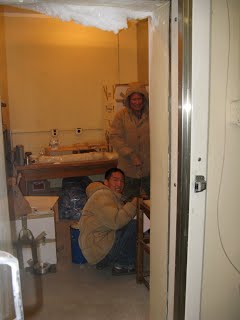

Mars Simulation Experiments
The Mars Odyssey spacecraft and the Mars Phoenix Lander have observed high concentrations of subsurface ice in the high-latitude regions. In the Ice Lab, we investigate the possibility that atmospherically derived water vapor can deposit ice, via diffusion, into a cold soil and may be able to fill or even exceed the available pore space volume. In the Ice Lab, parameters such as the vapor diffusion coefficient and thermal conductivity are being measured using Martian soil simulants.

(Right) Within the -40 ℃ freezer, one of two Mars environment chambers bristles with data, power, and fluid feed-throughs. The internal environment is maintained at 6 mbar pressure and very low humidity. This mimics Mars surface conditions at locations where buried ice is slowly lost to the atmosphere.
 (Left) An ongoing ice deposition experiment with cryogenic vacuum chamber. A computer-actuated series of mass-flow controllers flows carbon dioxide gas through a humidifying bubbler (glass sphere at bottom) and into the chamber which is continuously evacuated to maintain pressure. A methanol recirculating chiller (behind the table) cools a plate within the chamber to -90 ℃. This coupled with a heating lamp in a negative feedback loop creates a stable temperature gradient that drives vapor into the soil.
(Left) An ongoing ice deposition experiment with cryogenic vacuum chamber. A computer-actuated series of mass-flow controllers flows carbon dioxide gas through a humidifying bubbler (glass sphere at bottom) and into the chamber which is continuously evacuated to maintain pressure. A methanol recirculating chiller (behind the table) cools a plate within the chamber to -90 ℃. This coupled with a heating lamp in a negative feedback loop creates a stable temperature gradient that drives vapor into the soil.
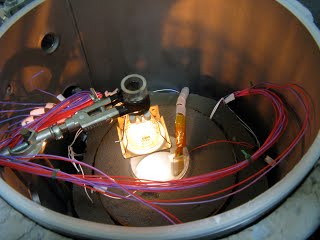 (Right) Within a vacuum chamber, two samples (here, two salt-encrusted discs of fine sand) overlie pure ice and retard its loss through their effect on the diffusion of vapor. Each sample is monitored for mass (to deduce flux), ice temperature, and both air temperature and relative humidity at their upper surfaces.
(Right) Within a vacuum chamber, two samples (here, two salt-encrusted discs of fine sand) overlie pure ice and retard its loss through their effect on the diffusion of vapor. Each sample is monitored for mass (to deduce flux), ice temperature, and both air temperature and relative humidity at their upper surfaces.
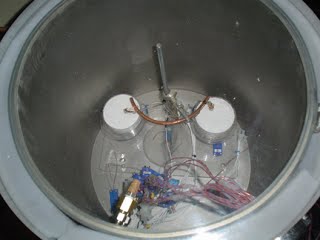 (Left) A lamp simulates solar heating of a Mars soil simulant. Once the chamber is closed, computer controlled temperature cycles pump vapor from a humid atmosphere into the soil. The same physical process works on Mars.
(Left) A lamp simulates solar heating of a Mars soil simulant. Once the chamber is closed, computer controlled temperature cycles pump vapor from a humid atmosphere into the soil. The same physical process works on Mars.
The Cryobot and Mini-Cryobot
Layered deposits in both residual polar caps on Mars suggest that a record of past climate exists there, analogous to climate histories derived from terrestrial ice cores. The visible expression arises from alternation between relatively dust-rich and dust-poor layers, while the invisible variation of isotopic ratios therein record conditions during past climates.
Cryobot team testing a prototype instrument designed to core, sample, and analyze the Mars polar cap ice. The tests were conducted at the Athabasca Glacier of the Columbia Ice Field, Alberta, Canada. The Cryobot probe is seen suspended within the borehole. From left to right: Donna, Oded Aharonson (Caltech), Hermann Engelhardt (Caltech), Greg Cardell (JPL), Scott Anderson (HIGP), Frank Carsey (JPL), and Mike Hecht (JPL).
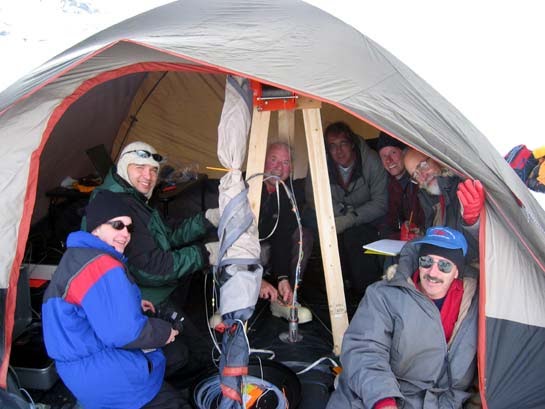
"Mini-Cryobot (MC)," is to serve as a first order approximation of the science that is to be conducted on Mars. Some of the baseline requirements of the MC is the ability to drill through water ice at a temperature of 173 K at the northern polar region of the Martian ice cap. It must be required to do so with a maximum power of 200 W continuously over a period of 72 hours to a week. Possible science to be conducted includes seismometry, ice stratigraphy, electrical conductivity, opacity, and thermal conductivity.

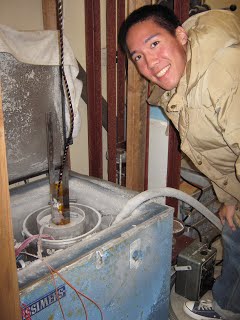
(Above) Three generations of the Cryobot.
(Right) The Mini-Cryobot drilling through -70 ℃ ice.
More information about this and other research is available in the form of published manuscripts here.






